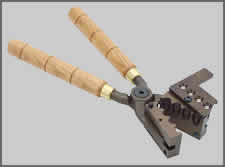- 01: Introduction
- 02: History
- 03: Propellants, Firearms, and Ammunition Development
- 04: Modern Firearms Manufacture
- 05: Small Arms Ammunition
- 06: Evidence Handling Procedures
- 07: Equipment and Instrumentation
- 08: Examination of Firearms
- 09: Cartridge and Shotshell Examination
- 10: Characterization and Evaluation of Fired Projectiles
- 11: Bullet Comparison and Identification
- 12: Gunshot Residue and Distance Determination
- 13: Toolmark Identification
- 14: Communicating Results
- Resources


Casting
Home > Small Arms Ammunition > Projectiles > Casting
Surviving to modern times, the all-lead bullet is the oldest type of cartridge projectile. Lead is a soft metal, easily worked by mechanical shaping or casting in molds. With simple equipment, it is readily alloyed with other low-melting-point metals (such as tin and antimony) to produce a harder final product.
Generally, lead projectiles are used for low-pressure and low-velocity cartridges, such as .22 caliber rimfire cartridges . Shotshells use lead pellets, although lead-free pellets are now required for waterfowl shooting.

Bullet mold
Casting bullets is the oldest manufacturing method, but it has limitations. Pouring molten lead into a mold to make quality bullets requires careful attention. Without monitoring lead temperature, mold temperature, pouring rates, alloy consistency, and cooling rates, the resulting bullets will not have the uniformity required by modern standards.
Casting has advantages, such as the ability to produce sharp edges and detailed surface features. Lead alloys that are too hard for cold forming may be cast. As factories became more reliant on power equipment, cold forming (or swaging) was widely adopted to speed production. Hard alloys were not required for the firearms of the day. Secondary operations (required when swaging failed to produce some bullet features like grooves that would have been cast) had to be developed.




